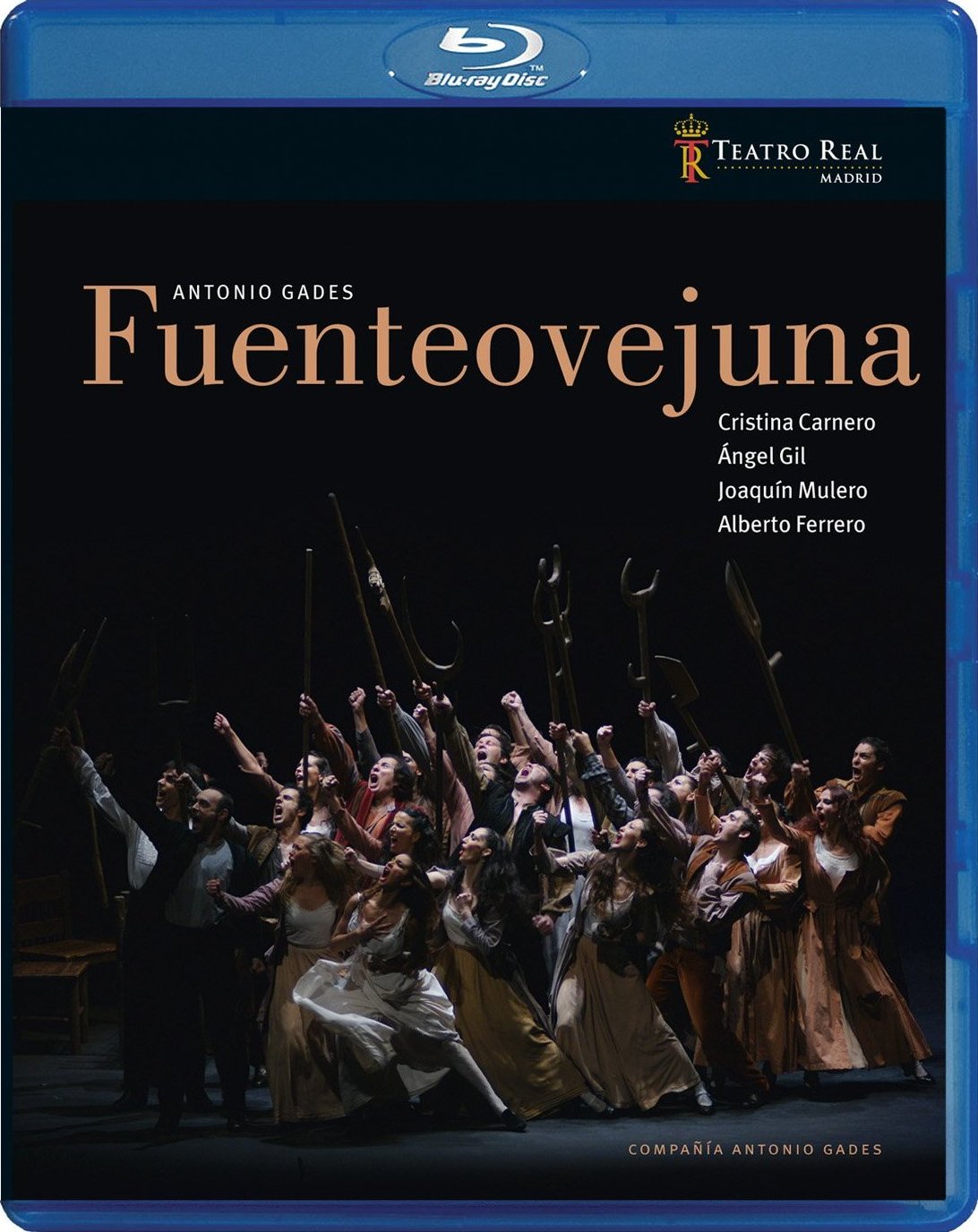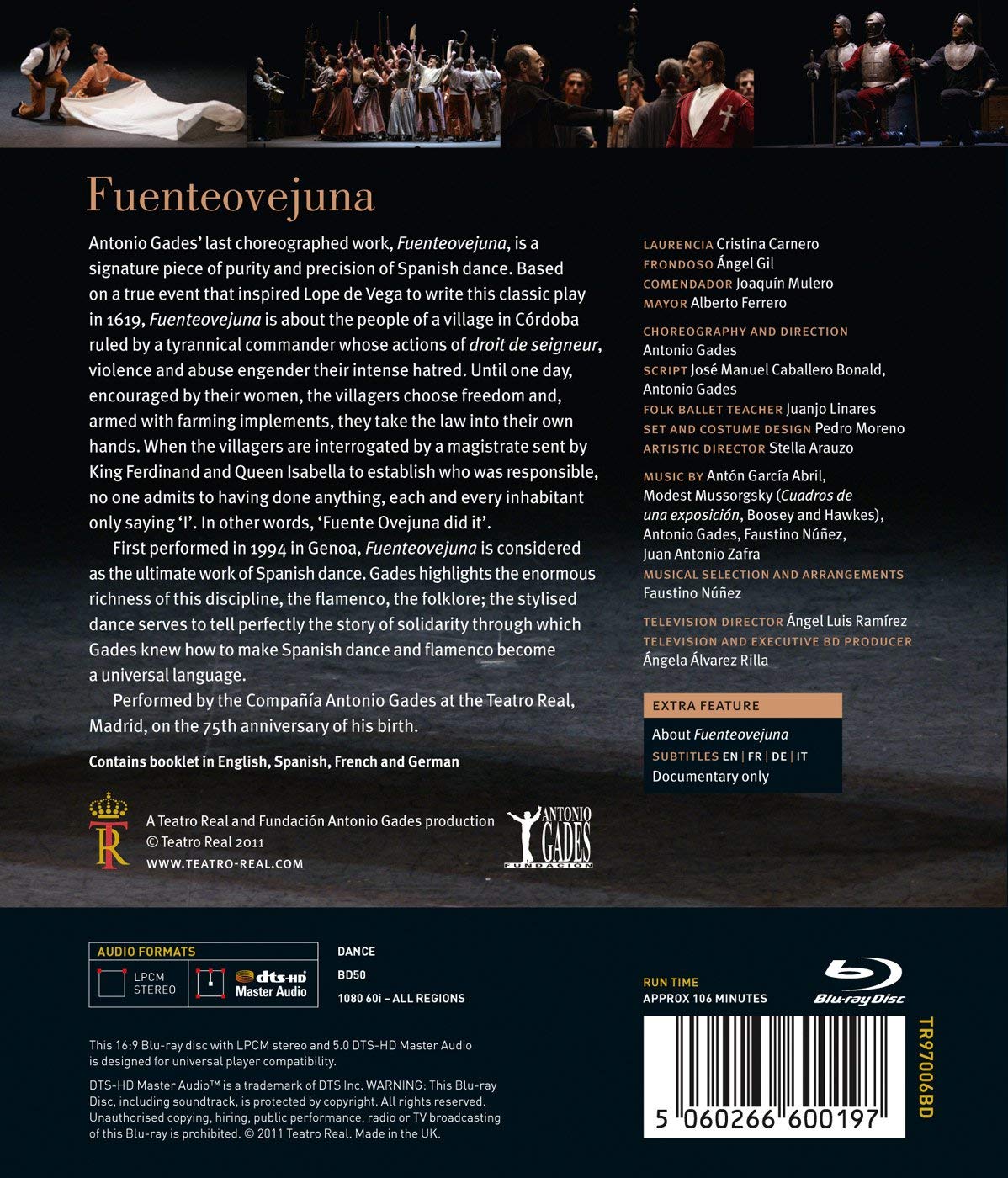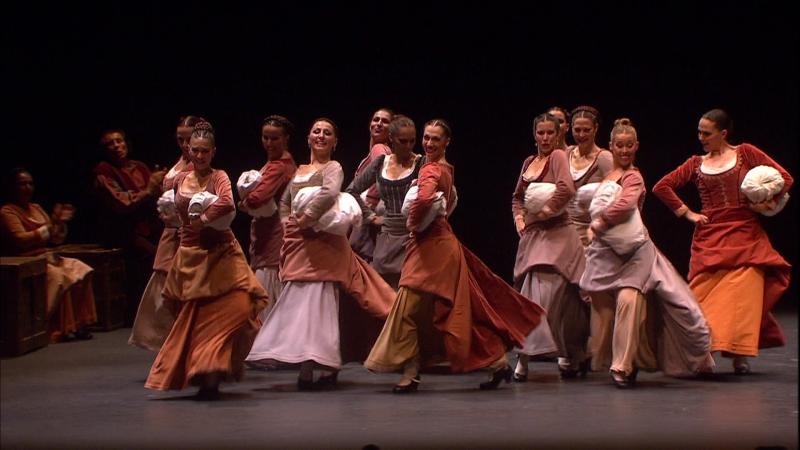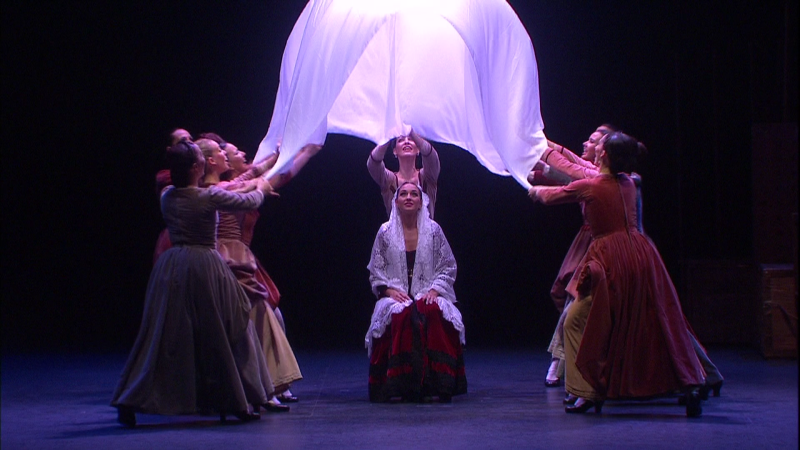

Fuenteovejuna flamenco dance piece. Directed and choreographed by Antonio Gades to a script by José Manuel Caballero Bonald and Antonio Gades. Stars Cristina Carnero (Laurencia), Ángel Gil (Frondoso), Joaquín Mulero (Comendador), and Alberto Ferrero (Mayor). Additional women dancers are Carolina Pozuelo, Conchi Maya, Luisa Serrano, Mª José López, Maite Chico, María Nadal, Merche Recio, Vanesa Vento, Virginia Domíguez, Virginia Guiñales, and Yolanda Rodríguez. Additional men dancers are Ángel Bleda, Antonio Mulero, David Martín, Elías Morales, Jairo Rodríguez, Miguel Lara, Miguel Vallés, and Pepe Vento. The flamenco woman singer is Ángela Núñez "La Bronce". Flamenco men singers are Alfredo Tejado, Enrique Pantoja, Gabriel Cortés, and Joni Cortés. Guitarists are Antonio Solera and Camarón de Pitita. Music by Antón García Abril, Modest Mussorgsky (Cuadros de una exposición), Antonio Gades, Faustino Núñez, and Juan Antonio Zafra. Set and costumes by Pedro Moreno; folk ballet instruction by Juanjo Linares. Directed for TV by Ángel Luis Ramírez; produced by Ángel Álvarez Rilla. Released 2012, disc has 5.0 dts-HD Master Audio sound. Grade: B+
This was Antonio Gades' last and artistically most ambitious work. The name means the "Sheepwell," which was also the name of a Spanish village. In 1476, the people of Fuenteovejuna rose up and killed an abusive government official. The King send investigators to catch the murderers. When questioned and tortured, all the villagers replied "Fuenteovejuna did it." Realizing the villagers had acted in self-defense, the King pardoned them. This event possibly would have been lost to history had not Lope de Vega written the play Fuenteovejuna in about 1614.
The Gades Fuenteovejuna is possibly the most expansive flamenco work ever because it contains strong elements of theater drama, remarkable sets and lighting, spoken parts, dancers singing as a chorus, dances from all over Spain (not just the Andalusian flamenco style), folklore, and recorded European classical music—all in addition to the traditional guitarists and and flamenco singers. The breadth of resources used by Gades suggests that Fuenteovejuna might be considered a "flamenco opera."
There is a lot of language used in this work. My wife, a native Spanish speaker, understands it well. But my Spanish comes from reading newspapers, and I understand very little of the words in Fuenteovejuna. In ordinary flamenco, you don't really care what the singers are wailing about—it's something desperately sad, and that's all you need to know. So flamenco pieces usually don't have subtitles in other languages. But I think Teatro Real made a big mistake in not providing Fuenteovejuna with subtitles in Spanish, other European languages, and Asian languages. I should also warn you that the English background material in the keepcase booklet is very poorly written. There are 26 chapters on the disc that have Spanish names listed in the keepcase booklet, and this can be big help in learning the story.
Time now for screenshots. It's harvest time, and Laurencia (Christina Carnero) is working in the fields with her sweetheart Frondoso (Ángel Gil):
The Comendador (Joaquín Mulero) visits in his red cloak of office at the same time Laurencia and Frondoso ask the Mayor (Alberto Ferrero) for permission to marry:
The peasants celebrate the harvest with many dances from all over Spain including this "bottle dance" where the men engage in elaborate footwork all around the bottle without knocking it over:
The Comendador has decided to exercise sovereign rights over Laurencia's virginity before she is allowed to marry:
The Mayor protests and is humiliated:
The villagers show their support for the mayor:
The festivities continue. Here's an elaborate dance about the joys of doing the laundry:
Frondoso is not about to let the Comendador have his way with Laurencia:
There follows a simple but strikingly beautiful wedding procession:
But the Comendador has returned with his forces fully armed, and they arrest Frondoso:
While the Mayor and the men of the village debate what to do, the Comendador rapes Laurencia:
The women challenge the men to stop talking and to act:
All the villagers rise up and kill the Comendador and his party:
Then the villagers shout repeatedly in unison: "I, I, I (killed the tyrant)." This is a bit different from the legend, which holds that the villagers said, "Fuenteovejuna killed him."
This admirable flamenco opera is very well put together and fun to watch. The black-box background and brilliant lighting yields many striking images. Gades gives you a lot to enjoy; but at an hour and 46 minutes, it's not too long. I just wish I could understand the spoken parts and the words of the dancers singing as a chorus. If this title had decent subtitles, it would get an "A" grade. Without the subtitles, I think "B+" is as high as I can go.























